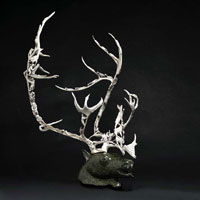|
|
Jackoposie Oopakak
Nunali c. 1988-89
Dark green stone, antler, sinew,
bone, steel, and black inlay
Purchased 2003
Born at Oopingnivik in the Cumberland Sound area of Baffin Island, Jackoposie Oopakak also grew up in "urban" Iqaluit (then called Frobisher Bay), where his family moved in the late 1950s to be near the American military base. At that time, Iqaluit was the main transfer point for travellers heading farther north or returning south. Oopakak began to carve alongside his father and other men settling in the town who benefited from the steady stream of visitors passing through. By 1978 he had achieved a level of fame locally, receiving regular commissions. His participation in a government-sponsored jewellery workshop familiarized him with precision tools, which facilitated his reputation for elaborately carved walrus tusks. Through the encouragement of Tom and Helen Webster of Iqaluit Fine Arts, Oopakak began to work on a larger scale, and with their assistance he held his first solo exhibition in 1990 at Vancouver's Marion Scott Gallery. The artist currently lives in Iqaluit.
Nunali is composed of a magnificent full set of caribou antlers mounted on a stone carving of a near life-size caribou head. Remarkable for its naturalism and large scale, this sculpture is more than simply a literal representation. Within the antlers' arcing shape - from the base to the tip of each branch - are the diminutive figures of an entire world order: Arctic birds, caribou, polar bears, seals, and whales are interspersed with human activities of fishing, hunting, cleaning skins, stretching boots, and travelling by dog sled and kayak. Following the antlers' natural shape, the movement of the figures depicted becomes inseparable from that of the branches themselves. Oopakak's title, Nunali - a simple translation is "place where people live" - suggests this interconnectedness, embracing as it does the tightly woven relationship of Inuit, animals, and their shared environment. Further still, the intricately detailed scenes appear to flow from the caribou itself, as if the artist had been able magically to give its thoughts a living, visible form.
Oopakak's interpretation of Inuit traditional life and his understanding of the antlers' round, friable material are physically and conceptually unified in this graceful merging of artistic vision and extraordinary carving ability. |

